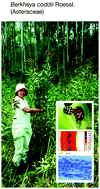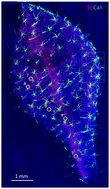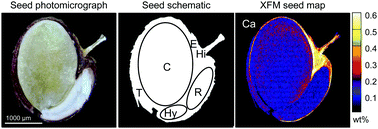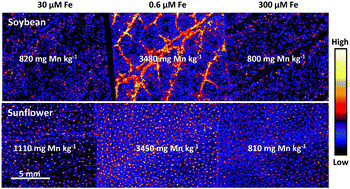Themed collection Phytometallomics

Phytometallomics
Antony van der Ent and Hugh Harris introduce the Metallomics themed issue on phytometallomics.

Metallomics, 2020,12, 324-325
https://doi.org/10.1039/D0MT90007A
Ecophysiology of nickel hyperaccumulating plants from South Africa – from ultramafic soil and mycorrhiza to plants and insects
Ecophysiological model “ultramafic soil – mycorrhiza – hyperaccumulating plants – specialised insects and other organisms” is presented for South African nickel hyperaccumulating plants.

Metallomics, 2020,12, 1018-1035
https://doi.org/10.1039/C9MT00282K
Biomolecular approaches to understanding metal tolerance and hyperaccumulation in plants
Trace metal elements are essential for plant growth but become toxic at high concentrations, while some non-essential elements, such as Cd and As, show toxicity even in traces.

Metallomics, 2020,12, 840-859
https://doi.org/10.1039/D0MT00043D
Distribution of aluminium in hydrated leaves of tea (Camellia sinensis) using synchrotron- and laboratory-based X-ray fluorescence microscopy
This study used X-ray fluorescence microscopy to reveal the distribution of aluminium in fresh hydrated plant tissues of Tea (Camellia sinensis).

Metallomics, 2020,12, 1062-1069
https://doi.org/10.1039/C9MT00300B
Elemental distribution and chemical speciation of copper and cobalt in three metallophytes from the copper–cobalt belt in Northern Zambia
Metallophytes from the Zambian copper–cobalt belt have a complex Cu–Co coordination chemistry and diverse elemental distribution at the tissue-level. This study reveals different ecophysiological responses in hyper-tolerant plant species growing in metalliferous environments.

Metallomics, 2020,12, 682-701
https://doi.org/10.1039/C9MT00263D
Distribution and chemical form of selenium in Neptunia amplexicaulis from Central Queensland, Australia
Elemental mapping of selenium in the hyperaccumulator Neptunia amplexicaulis determined whole plant and tissue level selenium distribution. The total concentrations and chemical forms of selenium are also reported for this species.

Metallomics, 2020,12, 514-527
https://doi.org/10.1039/C9MT00244H
Visible cellular distribution of cadmium and zinc in the hyperaccumulator Arabidopsis halleri ssp. gemmifera determined by 2-D X-ray fluorescence imaging using high-energy synchrotron radiation
SR-μ-XRF imaging has revealed that the distribution of Zn in leaves was different from that of Cd at a cellular level.

Metallomics, 2020,12, 193-203
https://doi.org/10.1039/C9MT00243J
X-ray fluorescence spectroscopy (XRF) applied to plant science: challenges towards in vivo analysis of plants
X-ray fluorescence spectroscopy presents a unique capability to probe the elemental content of plants in vivo, besides combination with other non-destructive tools to assess physiological processes.

Metallomics, 2020,12, 183-192
https://doi.org/10.1039/C9MT00237E
Identification and physiological comparison of plant species that show positive or negative co-occurrence with selenium hyperaccumulators
Reynolds and coworkers investigated effects of selenium hyperaccumulator plants on local vegetation. Shown is elemental distribution in Alyssum simplex.

Metallomics, 2020,12, 133-143
https://doi.org/10.1039/C9MT00217K
Endosperm prevents toxic amounts of Zn from accumulating in the seed embryo – an adaptation to metalliferous sites in metal-tolerant Biscutella laevigata
The pseudometallophyte Biscutella laevigata adapts to metalliferous soils by allocating excess metal(loid)s to the endosperm (E) of seeds to protect embryonic tissues and improve reproductive success.

Metallomics, 2020,12, 42-53
https://doi.org/10.1039/C9MT00239A
Evaluating effects of iron on manganese toxicity in soybean and sunflower using synchrotron-based X-ray fluorescence microscopy and X-ray absorption spectroscopy
Increased Fe in solution decreased Mn accumulation on soybean unifoliate leaves and in trichomes of sunflower lower alternate leaves.

Metallomics, 2019,11, 2097-2110
https://doi.org/10.1039/C9MT00219G
Spatially-resolved localization and chemical speciation of nickel and zinc in Noccaea tymphaea and Bornmuellera emarginata
Hyperaccumulator plants present the ideal model system for studying the physiological regulation of the essential (and potentially toxic) transition elements nickel and zinc.

Metallomics, 2019,11, 2052-2065
https://doi.org/10.1039/C9MT00106A
About this collection
This is a collection of papers consisting of invited contributions including reviews and original research articles that highlight the latest high-impact research on metals and metalloids that play key roles in the homeostasis of plants. Guest Edited by Antony van der Ent and Hugh Harris. New articles will be added to this collection as they are published.